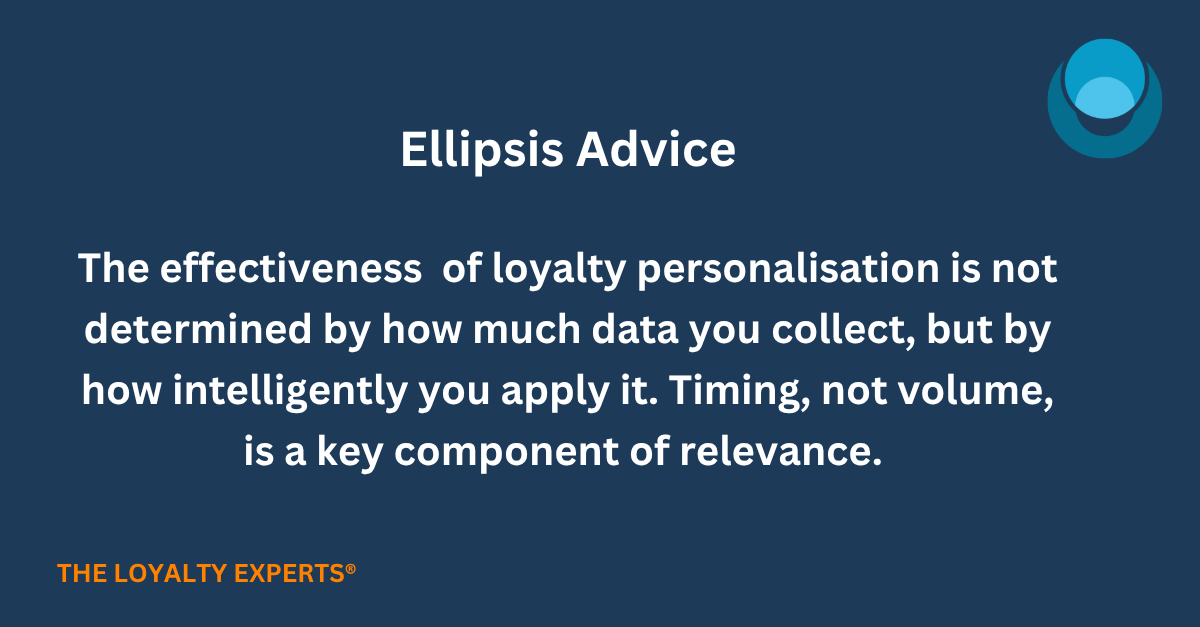
Less Is More, and Timing Is Everything
Marketers have long hailed personalisation as the path to unlocking incremental customer revenue, loyalty, and decisiveness by promising one-to-one relevance from first-party data. Yet, my inbox presents a scattershot stream of offers that are technically relevant, but often poorly timed, excessive, and/or confusing.
Nowhere is this more apparent than in grocery loyalty programs, with so many relevant products to promote, I receive an overload of choices. But ill-considered timing leads me to disengage rather than be delighted.
More isn't always better - timing defines true relevance, and a precision-led model of loyalty personalisation will outperform volume-based approaches.
Introduction
Armed with volumes of first-party data, brands are increasingly confident in their ability to make offers that reflect members’ preferences. But as grocery chains, retailers, and QSRs race to deliver personalised offers, at scale, the outcome is often the opposite of what was intended: customer fatigue, choice paralysis, and diminishing relevance.
Offers must be salient at Category Entry Points, which requires smarter timing, not just better targeting, to build effective customer connections.
Context
In the rush to appear relevant, marketers have overlooked a critical nuance: relevance is not a static attribute of an offer - it is contextual, temporal, and behavioural. An offer for paper towels may be relevant to a shopper based on past purchases, but if that customer bought a jumbo pack last week, the offer feels tone-deaf, borderline offensive, rather than timely and good value.
Academic research supports this common-sense view. The classic study by lyengar and Lepper (2000) found that extensive choice can actually demotivate consumers, reducing both decision satisfaction and likelihood of purchase1. Similar findings have emerged in recommender systems, where the “choice overload effect” shows that relevance alone doesn’t drive engagement; the paradox of choice is real - too many choices can blunt the impact of even well-targeted offers.
Yet many loyalty programs continue to equate more with better: more data, more segmentation, more offers. Grocery loyalty programs, in particular, flood members with pages of product discounts and bonus points earn opportunities, some useful, many ignored.
The Relevance Illusion
The illusion of relevance occurs when targeting is based purely on historic preferences. This approach creates two major pitfalls:
1. Timing Mismatch: Offers arrive too late, resulting in disinterest or annoyance. Dave, the Ellipsis CEO, received a generous discount and assembly offer just as he was finishing his DIY kitchen from a famous Scandinavian Loyalty Program. Don’t ever mention this if he has an Allen key in his hand!
2. Perceived Noise: Even relevant offers lose value when surrounded by too many others.
This is a classic problem of signal versus noise. Customers are wired to notice what’s timely and valuable, but when every interaction is “personalised,” nothing stands out.
Ellipsis’ Return on Loyalty® framework tackles this challenge head-on by isolating accurate engagement signals from transactional noise. Member Engagement Scoring separates wallet size from attention, enabling loyalty teams to measure not just what members buy, but when they are most receptive.
Recommendations
1. Restrain yourself: Limit the number of personalised offers per cycle. Fewer, more targeted offers have higher cut-through and perceived value. Test and find the ‘sweet spot’ for frequency with your category and customers.
2. Use Predictive Timing Models: Move beyond past purchase frequency to predictive signals. When will the next need likely arise? Are replenishment cycles understood at the individual level? You have the data to do this, and most CRM tools already support this functionality.
3. Incorporate Behavioural Signals: Track not only what is purchased, but how and when. A spike in search behaviour or digital activity can be a better predictor of intent than last week’s basket.
4. Test “No-Offer” Cohorts: Use control groups who receive no offer to benchmark actual incremental impact. Ellipsis' work in this area consistently shows inflated attribution in traditional models.
5. Prioritise Timing as a Vector of Personalisation: Recognise that an ill-timed 'relevant' offer is irrelevant. Ellipsis recognises that replenishment cycles are not always consistent; some customers have ‘clumpy’ purchase characteristics, they binge and recognising this as you time offers can be very lucrative.

The effectiveness of loyalty personalisation is not determined by how much data you collect, but by how intelligently you apply it. Timing, not volume, is a key component of relevance. Brands that learn to show up less often, but more precisely, outperform those that overwhelm.
In loyalty, as in life, the most powerful messages are often the simplest ones. Precision beats volume. Relevance is a moving target. And sometimes, the most personal thing to do is wait.
References:
1. Sheena S. Iyengar Mark R. Lepper When Choice is Demotivating: Can One Desire Too Much of a Good Thing? Journal of Personality and Social Psychology & Long, Sun, Dai, Zhang, Zhang, Chen, Hu, Zhao The Choice Overload Effect in Online Recommender Systems